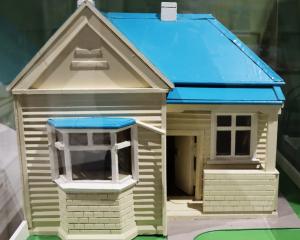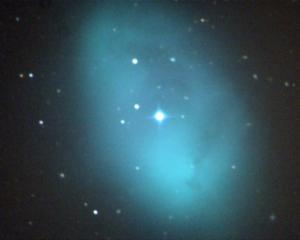A one-time hotel on Princes St was once more central to the life of the city, David Murray writes.
Since the demolition of its northern neighbour in the 1980s, the facade of this building has come to a slightly raggedy end, and the off-centre word ‘‘Hotel'' has looked a bit peculiar without the word ‘‘Central'' that once followed it. Although the two buildings that formed the Hotel Central had an integrated facade, they were separated by a party wall and had distinct roof structures. They were even built under separate contracts for different clients.
The surviving portion was built for the drapers Thomson, Strang & Co., and the demolished one for Dunning Bros. Built in 1873, the buildings replaced wooden structures that were only about 10 years old, but which in a period of rapid development were already seen as the antiquated stuff of pioneer days. The architects were Mason & Wales and the contractors Wood & Steinau.
The buildings were described in the Otago Daily Times as ‘‘very handsome'' but it was remarked that ‘‘their elevation and length appear to be altogether out of harmony with the irregularity of the comparatively small structures opposite''. The facade originally featured a bracketed cornice and most of the first-floor windows were hooded. Stone was used for the foundations and ground floor, and brick for the upper floors. Who were the Dunning brothers? Alfred Theodore Dunning and Frederick Charles Edward Dunning were English settlers who started out as fruiterers in Princes St in 1864. Frederick left the partnership in 1871, but returned for a few years later in the decade. In 1874 Alfred was granted a licence for the City Dining Rooms, which he opened upstairs in the new building. He established a hotel across the upper floors of both buildings, and from 1878 the establishment was known as Dunning's Central Hotel and Cafe. The portion above the drapery contained bedrooms, while rooms in the northern part included a dining room, offices, and a large billiard room.
Alfred was known for his joviality, uprightness in business, and warm-heartedness, but although he did well in the hotel business he was less successful when he left to take up theatrical management. He lost most of his money in opera ventures and died in Melbourne in 1886 at the age of 41. Frederick became a fruiterer in Christchurch, where he died in 1904 after falling from his cart.
The drapery firm Thomson Strang & Co. had started out as Arkle & Thomson in 1863. J.
R. Strang became a partner in 1866 and the firm operated from its new premises for 10 years, closing in 1883. From 1885 to 1928 the ground floor of this southern end of the buildings housed Braithwaite's Book Arcade. Joseph Braithwaite had established his business in Farley's Arcade in 1863 before the move to Princes St. The store had a horseshoe-shaped layout that extended into Reichelt's Building on the south side, and the horseshoe theme was carried through to distinctive frames over the two entrances. It was claimed more than 10,000 people once visited the arcade on a single day, and Braithwaite's became so well-known that it was considered a tourist attraction. It was a popular place to shelter from bad weather, and everyone from unchaperoned children to the local business elite might be seen browsing the shelves. By 1900 the business employed 30 salesmen and saleswomen.
The Central Hotel's licence was transferred to John Golder in 1881. He was succeeded by Robert T. Waters, who changed the name to the Baldwin Hotel, perhaps after the celebrated hotel of the same name in San Francisco. After Waters came Charles Nicholson, James D. Hutton, and Thomas Cornish. During Cornish's time the name changed back to Central Hotel, and later licensees were James Macdonald, E.
J. Power, William H. Haydon, and Catherine J. Haydon. The licence was lost in 1909, and the establishment afterwards continued as a private hotel and boarding house.
The Central Hotel featured in an unusual example of pioneering photography, for Dunedin at least. In 1903 a couple were photographed in a bedroom of the City Hotel from an opposite room in the Central Hotel, and the evidence was used in a divorce case. The respondent claimed she was only playing cards with the co-respondent, whom she described as an elderly, very short, stout, bald-headed, and not at all good-looking friend. The jury were unconvinced and a divorce was granted.
From 1916, the buildings included the entrance to the Empire Theatre (a cinema), complete with terrazzo flooring and marble mosaics. In 1935 the theatre's entrance was moved from Princes St to Moray Pl, and shops were built in the place of the old entry. The shops that have been in these buildings are too numerous to describe in detail here, but those in business for the longest periods included Cameron's Central Pharmacy, Carlton Bookshop, Ideal Knitwear Specialists, and London House (menswear). In the now-demolished building were Piccadilly Shoppe (lingerie specialists), Newall's Chinaware, Rob's Wool Shop, and the Elite Tea Rooms. The tearooms were established in 1915 and survived until 1973.
The facades were stripped of their Victorian decoration in 1952 and remodelled to the designs of architect L.
W.S. Lowther, incorporating late use of the Art Deco style. The name ‘‘Hotel Central'' was added in plain capitalised relief lettering at the parapet level. Directories and advertising suggest that for many years the names ‘‘Central Hotel'' and ‘‘Hotel Central'' were used interchangeably. The private hotel's last entry in Wise's directory was in 1977.
The northern building was demolished in 1987 to make way for additions to the Permanent Building Society building (now Dunedin House). This was remodelled in the postmodern style fashionable in the '80s, and its new features included tinted and mirrored glass, supersized pediments, and shiny columns. The older building now looks cut in half, but the changes made to the facade in the 1950s have exaggerated that effect. It recently changed ownership, so perhaps more change is in store in the not too distant future.
• For more from David Murray go to: builtindunedin.com.












